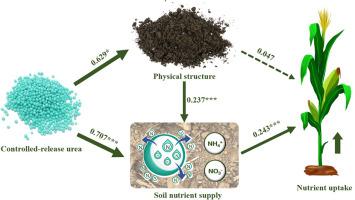Science of the Total Environment ( IF 9.8 ) Pub Date : 2021-05-15 , DOI: 10.1016/j.scitotenv.2021.147778 Yongxiang Gao 1 , Xue Song 1 , Kexin Liu 2 , Taige Li 1 , Wenkui Zheng 1 , Yong Wang 3 , Zhiguang Liu 4 , Min Zhang 4 , Qi Chen 1 , Zeli Li 1 , Ruochen Li 1 , Lei Zheng 5 , Wenlong Liu 5 , Tianyu Miao 1

|
Controlled-release urea (CRU) fertilizer application has been shown to improve crop yield and nitrogen (N) use efficiency. However, its effects when mixed with conventional urea fertilizer on soil aggregate stability, humic acid (HA) molecular composition and crop N uptake remain unclear. Soil and plant samples were collected from a long-term (2008–2019) experiment on field maize (Zea mays L., ‘Zhengdan 958’) which included two types of fertilizers [conventional urea fertilizer (CUF), blended CUF with CRU fertilizer (CRF)], four N application rates (0, 150, 300 and 450 kg ha−1), each in three replicates. The results showed that at 300 kg N ha−1, compared to CUF treatment, the CRF treatment significantly improved soil aggregate characteristics [aggregate content with particle size larger than 0.25 mm (R0.25) by 9.6%, mean weight diameter by 19.8%, and geometric mean diameter by 21.7%]. CRF treatment also increased HA content by 5.5%, fulvic acid (FA) by 5.5%, lignin-like molecules by 0.94 times, and protein-like molecules by 3.69 times. At grain-filling stage, CRF treatments significantly increased the sum of soil NH4+-N and NO3−-N content by 23.3–24.5%, sap bleeding rate by 12.8–18.2% and N delivery rate through bleeding sap by 60.6–87.7% compared to CUF treatments at the same N application rate. At the same rate of N application, the CRF treatments significantly improved the average yield during three growing seasons by 9.4–14.0% in contrast with CUF treatments. The regression equations showed that the maximum yield was 8294 kg ha−1 for CUF at the application rate of 312 kg N ha−1 while it was 9890 kg ha−1 for CRF at the application rate of 286 kg N ha−1. We conclude that the long-term application of CRF changed the HA molecular structure, enhanced the water stable aggregates, improved crop N uptake, and increased economically viable maize yield.
中文翻译:

控释和常规尿素肥料的混合物改变了土壤团聚体的稳定性,腐殖酸的分子组成和玉米的氮素吸收
控释尿素(CRU)肥料的施用已显示出可提高作物产量和氮(N)的利用效率。但是,当与常规尿素肥料混合使用时,其对土壤团聚体稳定性,腐殖酸(HA)分子组成和农作物氮吸收的影响尚不清楚。土壤和植物样品是通过对田间玉米(Zea mays L。,“ Zhengdan 958”)进行的长期(2008-2019年)试验收集的,其中包括两种肥料[常规尿素肥料(CUF),CUF与CRU肥料混合(CRF)],四个N施用量(0、150、300和450 kg ha -1),每个重复三次。结果表明,在300 kg N ha -1时与CUF处理相比,CRF处理显着改善了土壤团聚体特征[粒径大于0.25 mm(R 0.25)的团聚体含量增加了9.6%,平均重量直径增加了19.8%,几何平均直径增加了21.7%]。CRF处理还使HA含量增加5.5%,富里酸(FA)增加5.5%,类木质素分子增加0.94倍,使类蛋白质分子增加3.69倍。在灌浆期,CRF治疗显著提高了土壤的总和NH 4 + -N和NO 3 -与相同氮肥施用量下的CUF处理相比,氮素含量提高了23.3–24.5%,汁液出血率提高了12.8–18.2%,通过汁液的氮输送率提高了60.6–87.7%。在相同的氮肥施用量下,与CUF处理相比,CRF处理在三个生长季节的平均产量显着提高了9.4-14.0%。回归方程表明,最大收率为8294公斤公顷-1为CUF在312公斤氮公顷的施用率-1,而这是9890公斤公顷-1为CRF在286公斤氮公顷的施用率-1。我们得出的结论是,长期使用CRF可以改变HA的分子结构,增强水稳性团聚体,改善作物对氮的吸收,并增加经济上可行的玉米产量。



























 京公网安备 11010802027423号
京公网安备 11010802027423号